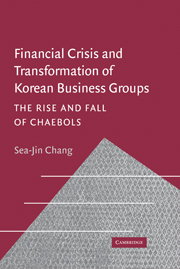Book contents
- Frontmatter
- Contents
- Preface
- 1 Introduction
- 2 The Evolution of Chaebols
- 3 Chaebols' Diversified Business Structure
- 4 Vertical Integration of Chaebols
- 5 The Capital Structure of Chaebols
- 6 Chaebols' Ownership and Governance Structure
- 7 The Restructuring of Chaebols
- 8 Conclusion
- Appendixes
- 1 Data Used in this Book
- 2 Comparing the Profitability of Group-affiliated Companies and Independent Companies
- 3 Profitability of Group-affiliated Firms
- 4 The Impact of Vertical Integration in Chaebols
- 5 Determinants of the Capital Structure of Chaebols
- 6 Profitability and Stock Ownership of Affiliates
- 7 Intragroup Business Transactions and Ownership Structures of the Top Five Chaebols
- 8 Key Economic Statistics
- Notes
- References
- Index
5 - Determinants of the Capital Structure of Chaebols
Published online by Cambridge University Press: 05 January 2010
- Frontmatter
- Contents
- Preface
- 1 Introduction
- 2 The Evolution of Chaebols
- 3 Chaebols' Diversified Business Structure
- 4 Vertical Integration of Chaebols
- 5 The Capital Structure of Chaebols
- 6 Chaebols' Ownership and Governance Structure
- 7 The Restructuring of Chaebols
- 8 Conclusion
- Appendixes
- 1 Data Used in this Book
- 2 Comparing the Profitability of Group-affiliated Companies and Independent Companies
- 3 Profitability of Group-affiliated Firms
- 4 The Impact of Vertical Integration in Chaebols
- 5 Determinants of the Capital Structure of Chaebols
- 6 Profitability and Stock Ownership of Affiliates
- 7 Intragroup Business Transactions and Ownership Structures of the Top Five Chaebols
- 8 Key Economic Statistics
- Notes
- References
- Index
Summary
This appendix examines the determinants of chaebol affiliates' capital structure. A firm's capital structure comprises its debts and equity capital. Modigliani and Miller (1958) argued that capital structure (i.e., whether a firm uses equity or debt) does not affect a firm's value when taxes are not an issue. More recent theory emphasized, however, that that cross-country variations in capital structure depend largely upon institutional factors. Here, this study attempted to identify the factors that lead chaebol affiliates to increase their debts by focusing on the debt-equity ratio as the dependent variable. This study further distinguished debts into two categories according to their maturity and their sources, and examined whether there are any differences in the factors that determine the type of debt used. In particular, this study tried to assess what role group-affiliated financial institutions play in determining the capital structures of their affiliates.
For this study, only interest-bearing corporate debts were considered, excluding liabilities such as accounts payable. The debt-equity ratio was calculated by dividing interest-bearing debts by equity capital. This study further classified debts as short-term or long-term debts according to whether they matured in less than a year (SHORT-TERM DEBTS) or more than a year (LONG-TERM DEBTS). It also classified the debts as DOMESTIC or FOREIGN according to their sources of origin.
This study used several explanatory variables, including several that were employed in Appendix 3 such as the PROFITABILITY, measured by the return on invested capital.
- Type
- Chapter
- Information
- Financial Crisis and Transformation of Korean Business GroupsThe Rise and Fall of Chaebols, pp. 284 - 290Publisher: Cambridge University PressPrint publication year: 2003

